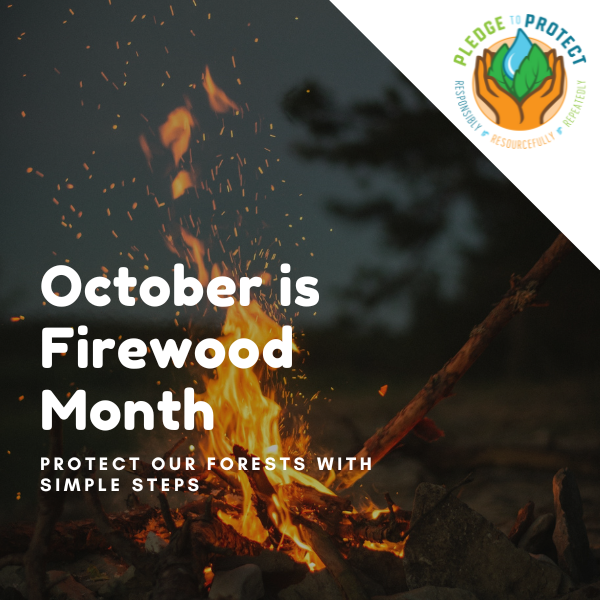This Protector’s Activity was contributed by Laurel Downs, the Forest Health Conservation Coordinator with The Nature Conservancy.
What's The Issue?
Did you know that transporting firewood can unknowingly spread invasive forest pests and diseases to new areas? Invasive species like the emerald ash borer (Agrilus planipennis), invasive longhorned beetle (Anoplophora glabripennis), and spotted lanternfly (Lycorma delicatula) can hide within firewood for months, even surviving harsh winters. When firewood is moved from one location to another, these species often emerge and cause devastating damage to forests.
Due to the prevalence of hitchhiker pests, many states and parks have rules to encourage the use of local and/or certified, heat-treated firewood. For example, here in New York it is against the law to move untreated firewood more than 50 miles from where it originated. To be considered “treated” in New York, a government certified facility must subject the firewood to a heat-treatment process that is hot enough – and for long enough – to kill any pests in the wood (in New York this standard is 71° C (160° F) for 75 minutes). The state prohibits the entry of firewood that does not meet this standard! (View Firewood Regulations).
What Can You Do to Help?
Your firewood choices matter and you can help slow the spread of tree-killing pests and diseases by following some best practices, no matter where you are!
- Buy or source firewood from where you’ll burn it.
- Buy certified, heat-treated firewood (it’s the ONLY safe firewood to travel with).
- Responsibly gather firewood on-site when permitted.
By sourcing your firewood locally, and keeping it local, you dramatically reduce the risk of accidentally transporting invasive species that could go on to decimate tree populations in new areas.
What to Look For
It’s nearly impossible to tell if firewood contains harmful insects. If you need to travel with firewood, make sure to purchase certified, heat-treated firewood (in New York, look for the label “New York Approved Heat-treated Firewood/Pest Free” with the producer’s name and address), or keep the firewood as close as possible to its original source.
Follow the rules to protect our trees! Any firewood you transport in New York should include documentation of its source, origin, or heat treatment. Even if you’re traveling with firewood cut for personal use, carry a Self-Issued Certificate of Origin – this can save you from losing your firewood or facing a hefty fine!
Use these tools to learn more about firewood regulations and where to source local firewood.
Don’t Move Firewood Webinar Series
The Don’t Move Firewood campaign is planning a series of informative webinars in early 2025. The webinars will be focused on firewood movement regulations, outreach, and the impact of invasive forest pests. Experts will discuss the importance of comprehensive online outreach strategies and give updates on their social media message frame testing.
For more information visit the Don’t Move Firewood website.
Upcoming Events
Learn to survey for and report invasive hemlock woolly adelgid (HWA). Guided hikes will be held from 10 a.m. – 12 p.m. on the following dates:
- October 30: Inman Glide Trail, Rodman, NY
- November 15: Great Bear Rec. Trail, Fulton, NY
- December 5: Salmon River Falls, Richland, NY
- January 17, 2025: Trenton Greenbelt Trail, Holland Patent, NY
- February 14, 2025: Forest Park, Camden, NY
You’re invited to attend a series of guided hikes to learn how to survey hemlock trees for the presence of an invasive insect called Hemlock Woolly Adelgid (HWA). This insect kills hemlock trees which are key beneficial tree species in New York State and beyond. HWA is known to be present in Oswego County and can easily be spread to other parts of the Eastern Lake Ontario Region such as the Tug Hill Forest.
Attendees will be trained to use the iMapInvasives mobile app to report HWA sightings, playing an important role in tracking and managing the spread of this pest.
Registration is required to attend. Participants are encouraged to create a free iMapInvasives user account and download the mobile app before attending, though this is not mandatory. The hikes will proceed unless severe weather forces a cancellation, in which case participants will be notified via email.

Help Spread the Word
Help spread the word! October is one of the best times to enjoy the outdoors in New York and a popular season for camping. It’s also the perfect time to remind friends and family about the risks to forest health caused by moving firewood.
Use the premade graphics and captions below to encourage others to buy firewood near their destination. Many parks sell firewood at the campground store or can direct you to nearby vendors. This helps protect trees—and saves space in your trunk! (Get more graphics and sources in the Don’t Move Firewood Resource Library)












Did you enjoy this blog post? Take our Pledge to Protect and get monthly emails showcasing actions you can take to protect your favorite hiking trails, paddleways, forests, garden, and community from the impacts of invasive species!
Take the Pledge to Protect
The Pledge-to-Protect is a fun, positive, inviting, engaging and rewarding way to participate in invasive species prevention and management.
|
|



